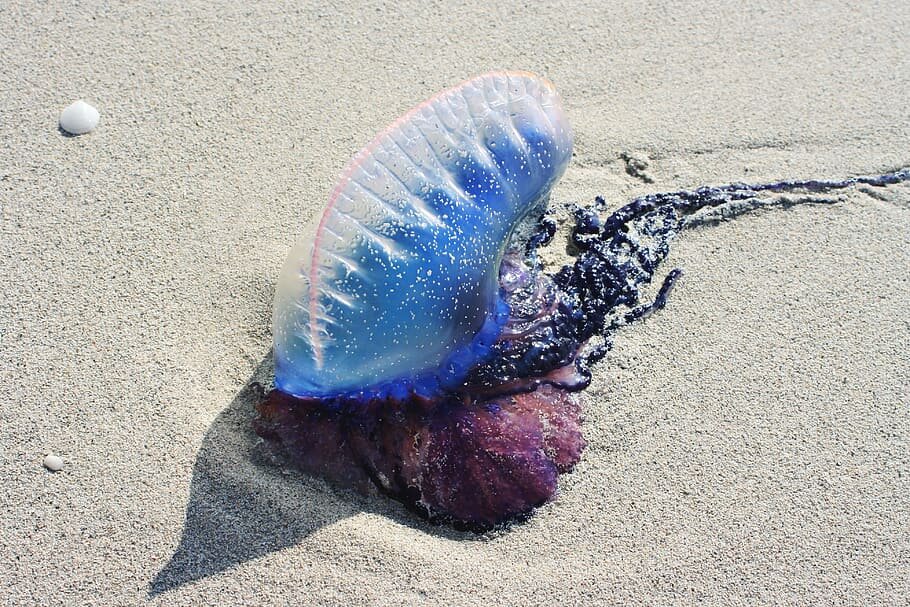Portuguese Man o’ War: The Facts
Words by Lydia Paleschi
Autumn is well and truly upon us. The return of the winter swells and the increase in wind speed has brought not only the arrival of surf, but also the Portuguese Man o’ War. It’s normal to see these deposited around the coastline of Cornwall this time of year, when south westerly storms blow them in from the Atlantic. Whilst these guys do pack a nasty sting, they are also incredibly beautiful creatures to be admired from afar.
Here’s everything you need to know:
Q & A
What is a Portuguese Man o’ war?
A Portuguese Man o’ War (Physalia Physalis) is easy to identify as they are deep blue/ purple in colour and have an air filled ‘sack’ which floats on the surface of the water. Often assumed to be a type of jellyfish, it is in fact a hydrozoan – a colony of four different species which work together symbiotically. The balloon is one organism which keeps the colony afloat on the water's surface, the tentacles are a second organism which are covered with a number of stinging cells, the third composes the reproductive parts and the fourth organism comprises a basic digestive system.
They are not to be confused with a by-the-wind-sailor which pose no threat to to humans.
A By-The-Wind-Sailor is of similar colouration to the Portuguese Man o’ War but is a completely different species
Where do Portuguese Man o’ War come from?
Portuguese Man o’ Wars are found, sometimes in groups of 1,000 or more, floating in warm waters throughout the world's oceans. They are primarily found in tropical and subtropical oceans, however it is common for them to wash up on UK beaches during the autumn months.
What time of the year do you find Portuguese Man o’ War in the UK?
You can expect to find them washed up on shore lines in the autumn months in varying numbers from year to year.
Where am I most likely to find Portuguese Man o’ War?
You’re most likely to see them washed up on the beach in heavy autumnal swells. Keep an eye out for them tangled in seaweed or on rocks.
Are Portuguese Man o’ War easy to spot in the water?
The balloon or sack part of a Portuguese Man o’ War is easy to spot. Reaching up to six inches in height and bright blue or purple in colour you can see it from a distance. However, their long trailing tentacles can reach up to 50m metres long and are much more difficult to see. Near invisible to spot in the water, these tentacles can become detached from the float and pose a hidden threat.
It’s also worth knowing that at times they deflate and submerge themselves under the water’s surface in order to avoid predators.
How do Portuguese Man o’ War move?
Much like jellyfish, the Portuguese Man ’o War drift around the world’s oceans, propelled by the wind and ocean currents. They spend most of their time out at sea and we mostly only see them when high winds propel them to shore and they are washed up on our beaches.
How long are Portuguese Man o’ War tentacles?
A Portuguese Man o’ War’s tentacles can reach up to fifty metres in length!
Can Portuguese Man o’ War kill humans?
Whilst it is commonly assumed that a sting from one of these is likely to be fatal, this is in fact a rare occurrence.
A Portuguese Man o’ War’s tentacles are covered with stinging cells, loaded with coils which administer venom. A sting will leave stringy red welts on the skin which can last up to several hours. You can also expect pain in the affected area, including burning, swelling and redness. Stings are meant to be extremely painful and are often accompanied with muscle cramps, elevated heart rates, and vomiting. In rare cases stings can be fatal if there is an allergic reaction because of the resulting anaphylactic shock.
Can Portuguese Man o’ War sting when they’re dead?
Even if their tentacles become detached from the balloon or they’re washed up dead on the beach they still sting.
What to do if you’re stung by a Portuguese man o’ War?
Tentacles stick to the skin, therefore you should rinse the area with salt water and use tweezers to remove any stings or tentacles stuck to the skin. Do this as soon as possible, because whilst in contact with the skin the stinging cells will continue to release venom.
The NHS advises soaking the area in very warm water (as hot as can be tolerated) for at least 30 minutes and taking painkillers such as paracetamol and ibuprofen.
Others suggest you apply cortisone cream.
What should I do if I find a Portuguese Man o’ War?
It’s important to keep your distance and admire them from afar. The Marine Strandings Network urges anyone who sees a Portuguese Man o' War to contact them immediately on 0345 2012626.
Can I still swim when Portuguese Man o’ War are around?
It is still possible to swim when there are Portuguese Man o’ War nearby, however there is some risk of being stung. If there are high numbers around it’s probably best to stay out of the water.
How do Portuguese Man o’ War reproduce?
Portuguese Man o’ War reproduce sexually via a method known as broadcast spawning. This involves large groups coming together, with females releasing their eggs and males releasing their sperm accordingly. This mass mating method increases the likelihood of eggs being fertilised.
What do Portuguese Man o’ War eat?
Portuguese Man o’ War are a carnivorous species. Using its venomous tentacles which trail below the water’s surface at lengths of up to fifty meters, it catches and paralyses its prey whilst "reeling" it inwards to the digestive polyps. It typically feeds on small marine organisms, such as fish, pelagic crustaceans, and other invertebrates.
What eats Portuguese Man o’ War?
Loggerhead sea turtles and ocean sunfish are amongst the few predators that specialise in consuming stinging, gelatinous invertebrates and therefore prey on Portuguese man o’ War.
Why are they called a Portuguese Man-o-War?
Because of their resemblance to an 18th-century Portuguese warship under full sail.
If you have any more questions about the Portuguese Man o’ War, leave them in the comments below.
You can also find out everything you need to know about jellyfish native to Cornish waters via our blog Jellyfish Explained: A Guide to Jellyfish in Cornwall and the UK.
If you enjoyed this blog, why not sign up to our newsletter?
If you know someone else who would enjoy it, please share it with them via email or social media.


